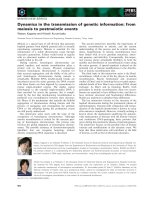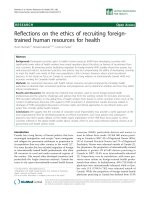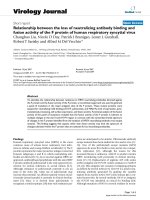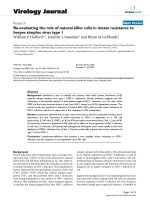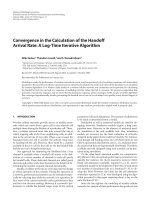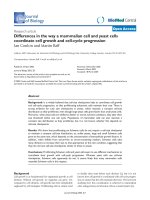Báo cáo sinh học: "Trees in the Web of Life" pot
Bạn đang xem bản rút gọn của tài liệu. Xem và tải ngay bản đầy đủ của tài liệu tại đây (602.2 KB, 4 trang )
Minireview
TTrreeeess iinn tthhee WWeebb ooff LLiiffee
Kristen S Swithers, J Peter Gogarten and Gregory P Fournier
Address: Department of Molecular and Cell Biology, University of Connecticut, 91 North Eagleville Road, Storrs, CT 06269-3125, USA.
Correspondence: Gregory P Fournier. Email:
The Tree of Life (ToL) is a widely used metaphor to describe
the history of life on Earth. While Darwin argued that the
‘Coral of Life’ may be a more apt description (since only the
surface remains alive, supported by the dead generations
beneath it), relationships between organisms based on
shared characters are best organized using the schematic
representation of a tree. Use of molecular markers, in
particular small-subunit ribosomal RNA, have allowed this
metaphor to be extended to microorganisms; however, this
has also presented unique challenges for notions of
phylogeny and evolution. One of the most significant
challenges is the impact of horizontal gene transfer, which
causes genes that coexist in a genome to have different
molecular phylogenies [1]. Despite these challenges, the
increasing ease with which genomes can be sequenced has
reinvigorated attempts to use genomic information to
reconstruct the ToL.
CCoommbbiinniinngg ddaattaasseettss:: ssuuppeerrttrreeee aanndd ssuuppeerrmmaattrriixx
mmeetthhooddss
All microbial individuals arise as the result of a fission of a
parent individual. Therefore, a vertical line of descent exists,
and could theoretically be reconstructed as a purely bifur-
cating tree (that is, an organismal or cytoplasmic tree).
However, while evolution presupposes and requires descent
via reproduction, the two are not analogous. Evolution is, by
definition, the change in the genetic material within a
population of organisms across generations; therefore, any
process by which genetic material within a population
changes that is unrelated to the reproduction of individuals
will show a history that is unrelated to the organismal vertical
line of descent. This includes horizontal gene transfer. In
many cases, the sum effect of these other genetic processes
may completely obfuscate vertical descent, leaving only some
measure of ‘relatedness’ based on overall genetic similarity.
Two common approaches in constructing a genome-based
ToL are supermatrix analyses, in which sequence alignments
for individual gene families are concatenated into a single
dataset that is then used to construct a tree [2], and
supertree analyses, in which a consensus phylogeny is
constructed from multiple gene trees [3]. In some cases,
datasets are generated by finding orthologous genes in all
organisms and removing all genes whose conflicting
phylogenetic topologies seem to indicate horizontal gene
AAbbssttrraacctt
Reconstructing the ‘Tree of Life’ is complicated by extensive horizontal gene transfer
between diverse groups of organisms. While numerous conceptual and technical obstacles
remain, a report in this issue of
Journal of Biology
from Koonin and colleagues on the largest-
scale prokaryotic genomic reconstruction yet attempted shows that such a tree is discernible,
although its branches cannot be traced.
Journal of Biology
2009,
88::
54
Published: 13 July 2009
Journal of Biology
2009,
88::
54 (doi:10.1186/jbiol160)
The electronic version of this article is the complete one and can be
found online at />© 2009 BioMed Central Ltd
transfer, and then using the remaining genes to reconstruct
the presumed vertical lines of descent of the genomes (see,
for example, [4-6]). This approach has an obvious short-
coming in that gene transfer and the resulting phylogenetic
conflicts can only be inferred if each individual gene has
retained sufficient phylogenetic information to enable its
origin to be correctly assigned. Furthermore, the absence of
evidence for gene transfer does not constitute evidence for
the absence of gene transfer. Thus, combining genes with
different histories into a single data set will almost certainly
result in a phylogeny that represents neither the history of
any individual gene, nor the history of the organism as a
whole. Another problem with supermatrix and supertree
analyses is that they often give equal weight to genes that
have different histories of horizontal gene transfer. This
results in an average or median phylogeny that may not
represent organismal history; if there are ‘highways’ of gene
sharing - that is, large numbers of genes have, for some
reason, been shared between specific groups of otherwise
phylogenetically distinct organisms - this can easily be
mistaken for a consistent signal supporting an organismal
tree. For example, because of such highways of gene sharing
these types of analyses group members of the order
Thermotogales with the Firmicutes, and the members of the
54.2
Journal of Biology
2009, Volume 8, Article 54 Swithers
et al.
/>Journal of Biology
2009,
88::
54
FFiigguurree 11
The Tree of Life as impacted by horizontal gene transfer.
((aa))
Extensive horizontal gene transfers at all phylogenetic levels combine to produce a
‘Web of Life’ that often obscures the lines of descent between groups (modified from [10]). Copyright (2008) National Academy of Sciences, U.S.A.
((bb))
Major microbial groups as defined by 16S ribosomal RNA phylogeny. Bands represent some avenues of extensive gene sharing involving
Thermotogales, Aquificales, and Firmicutes.
((cc))
Impact on relationships between Thermotogales and Aquificales of genome content changes due to
extensive horizontal gene transfer. Grey clouds represent groups of shared genes between clades that are non-monophyletic in the 16S tree. The
phylogeny based on these ‘gene content’ clouds is quite distinct from that of 16S or other ribosome-based trees.
(a)
(b)
(c)
Epsilonproteobacteria
Aquificales
Aquificales
Crenarchaea
Korarchaea
Nanoarchaea
Euryarchaea
Thermotogales
Thermotogales
Deinococcus/
Thermus
Firmicutes
Firmicutes
Firmicutes
Deltaproteobacteria
Epsilonproteobacteria
Alphaproteobacteria
Betaproteobacteria
Gammaproteobacteria
Chlamydiae
Cyanobacteria
Spirochetes
Bacteroidetes/
Chlorobi
Actinobacteria
Euryarchaea
Aquificales with the ε-Proteobacteria. In contrast, 16S rRNA
gene phylogenies and concatenated ribosomal protein
phylogenies strongly support these two orders as deeply
branching bacterial lineages [7,8] (Figure 1).
RRiibboossoommaall ttrreeeess aanndd tthhee ‘‘ggeennoommee ccoorree’’
If stringent criteria are applied to remove or down-weigh
transferred genes from supertree or supermatrix analyses,
the resulting trees at best represent the history of only a
minor fraction of the genome, largely consisting of ribo-
somal proteins, effectively a ‘tree of one percent’ [9]. Even if
this remaining ‘genome core’ retains a strong signal of
vertical descent, this does not capture the true evolutionary
history of genomes; that is, a web where different strands
depict the history of different genes. A ribosomal tree of life
has other shortcomings, in that within taxonomic orders
many recombination and lineage sorting events may occur,
and ribosomal genes are so highly conserved that such
events at the tips of the tree may not be detectable. How-
ever, it can still provide a useful backbone for a reticulated
genomic or organismal phylogeny [10,11], especially with
respect to sets of genes that clearly have undergone
horizontal transfer between more distantly related groups.
While ribosomal protein and RNA encoding genes have
been transferred in the past (see discussion in [12]), these
genes are resistant to transfer [13], with most transfers
occurring between close relatives. These properties make a
phylogenetic reconstruction using ribosomal RNA and
proteins an ideal scaffold upon which to map horizontal
gene transfers, clearly depicting their distinct contribution
to genomic (and organismal) evolution. Several attempts
have been made to capture this web-like genome history
(see, for example, [10,11] using ribosomal rRNA as a
backbone (Figure 1). Conceptually, this method is distinct
from any ‘tree of one percent’ [9] or genome averaging
approach in that rather than being discarded, genes
undergoing horizontal transfer are included in the final
reconstruction without obscuring the vertical signal, even if
that vertical signal is preserved only in a minority of genes.
TThhee FFoorreesstt ooff LLiiffee
In this issue, Puigbo, Wolf and Koonin [14] present an
approach for salvaging the ToL that is a variant on other
supertree methods, in which nearly 7,000 phylogenetic trees
of prokaryotic genes (a ‘Forest of Life’) are compared in
order to determine a central tendency in their topologies.
The trees are built from clusters of orthologous groups of
proteins (COGs), and the central tendency is deduced from
a set of nearly universal trees (NUTs), defined by Puigbo et
al. as those trees generated from a set of COGs that are
represented in >90% of the analyzed prokaryote taxa. What
distinguishes their approach from earlier supertree
analyses - apart from the very large number of genes
included in the comparison - is that it does not depend
on a concatenation of highly conserved proteins or
rRNAs, or on a supertree generated by ‘pruning’ down to
those genes giving a consistent topology, to determine a
central tendency. Instead, Puigbo et al. calculate an
‘inconsistency score’ that is a measure of how
representative a particular topology of each tree is to the
rest of the trees in the Forest of Life.
In reconstructing the central tendency in such a broad
distribution of gene phylogenies, the work by Puigbo et al.
also shows the difficulty in resolving deep branches, which
often simply collapse into radiations without any topo-
logical structure. In confronting this problem, they show
that the relationship between phylogenetic depth and
resolution supports a tree-like structure for these deep
branches. This result is significant in that it suggests that
there is no need to postulate exotic ‘big bang’ radiations
early in evolution; rather, deep phylogenies can still be
represented as bifurcating evolutionary events, albeit with
extremely short branches that can prove difficult (or
sometimes impossible) to resolve.
Integrating the vertical descent of organisms and their
genomes with the myriad phylogenetic patterns produced
by horizontal gene transfer is essential for a truly compre-
hensive understanding of evolution. A new method that
acknowledges and promotes this integration, even if falling
short of fully encompassing the intricate details of a
complex genome-based biological reality, represents
progress towards this goal, and it now appears that a vertical
signal can be discerned, if not clearly resolved.
AAcckknnoowwlleeddggeemmeennttss
Work in the authors’ lab is supported through the NSF Assembling the
Tree of Life (DEB 0830024) and NASA exobiology (NAG5-12367 and
NNX07AK15G) programs.
RReeffeerreenncceess
1. Gogarten JP, Townsend JP:
HHoorriizzoonnttaall ggeennee ttrraannssffeerr,, ggeennoommee iinnnnoo
vvaattiioonn aanndd eevvoolluuttiioonn
Nat Rev Microbiol
2005,
33::
679-687.
2. Delsuc F, Brinkmann H, Philippe H:
PPhhyyllooggeennoommiiccss aanndd tthhee rreeccoonn
ssttrruuccttiioonn ooff tthhee ttrreeee ooff lliiffee
Nat Rev Genet
2005,
66::
361-375.
3. Bininda-Emonds OR:
TThhee eevvoolluuttiioonn ooff ssuuppeerrttrreeeess
Trends Ecol
Evol
2004,
1199::
315-322.
4. Ciccarelli FD, Doerks T, von Mering C, Creevey CJ, Snel B, Bork
P:
TToowwaarrdd aauuttoommaattiicc rreeccoonnssttrruuccttiioonn ooff aa hhiigghhllyy rreessoollvveedd ttrreeee ooff
lliiffee
Science
2006,
331111::
1283-1287.
5. Galtier N, Daubin V:
DDeeaalliinngg wwiitthh iinnccoonnggrruueennccee iinn pphhyyllooggeennoommiicc
aannaallyysseess
Philos Trans R Soc Lond B Biol Sci
2008,
336633::
4023-4029.
6. Wu M, Eisen JA:
AA ssiimmppllee,, ffaasstt,, aanndd aaccccuurraattee mmeetthhoodd ooff pphhyyllooggee
nnoommiicc iinnffeerreennccee
Genome Biol
2008,
99::
R151.
7. Boussau B, Gueguen L, Gouy M:
AAccccoouunnttiinngg ffoorr hhoorriizzoonnttaall ggeennee
ttrraannssffeerrss eexxppllaaiinnss ccoonnfflliiccttiinngg hhyyppootthheesseess rreeggaarrddiinngg tthhee ppoossiittiio
onn ooff
aaqquuiiffiiccaalleess iinn tthhee pphhyyllooggeennyy ooff BBaacctteerriiaa
BMC Evol Biol
2008,
88::
272.
/>Journal of Biology
2009, Volume 8, Article 54 Swithers
et al.
54.3
Journal of Biology
2009,
88::
54
8. Zhaxybayeva O, Swithers KS, Lapierre P, Fournier GP, Bickhart
DM, DeBoy RT, Nelson KE, Nesbø CL, Doolittle WF, Gogarten
JP, Noll KM:
OOnn tthhee cchhiimmeerriicc nnaattuurree,, tthheerrmmoopphhiilliicc oorriiggiinn,, aanndd
pphhyyllooggeenneettiicc ppllaacceemmeenntt ooff tthhee TThheerrmmoottooggaalleess
Proc Natl Acad
Sci USA
2009,
110066::
5865-5870.
9. Dagan T, Martin W:
TThhee ttrreeee ooff oonnee ppeerrcceenntt
Genome Biol
2006,
77::
118.
10. Dagan T, Artzy-Randrup Y, Martin W:
MMoodduullaarr nneettwwoorrkkss aanndd
ccuummuullaattiivvee iimmppaacctt ooff llaatteerraall ttrraannssffeerr iinn pprrookkaarryyoottee ggeennoommee eevvoolluu
ttiioonn
Proc Natl Acad Sci USA
2008,
110055::
10039-10044.
11. Gogarten JP:
TThhee eeaarrllyy eevvoolluuttiioonn ooff cceelllluullaarr lliiffee
Trends Ecol Evol
1995,
1100::
147-151.
12. Gogarten JP, Doolittle WF, Lawrence JG:
PPrrookkaarryyoottiicc eevvoolluu
ttiioonn iinn lliigghhtt ooff ggeennee ttrraannssffeerr
Mol Biol Evol
2002,
1199::
2226-
2238.
13. Sorek R, Zhu Y, Creevey CJ, Francino MP, Bork P, Rubin EM:
GGeennoommee wwiiddee eexxppeerriimmeennttaall ddeetteerrmmiinnaattiioonn ooff bbaarrrriieerrss ttoo hhoorriizzoonn
ttaall ggeennee ttrraannssffeerr
Science
2007,
331188::
1449-1452.
14. Puigbo P, Wolf YI, Koonin EV:
SSeeaarrcchh ffoorr aa ‘‘TTrreeee ooff LLiiffee’’ iinn tthhee
tthhiicckkeett ooff tthhee pphhyyllooggeenneettiicc ffoorreesstt
J Biol
2009,
88::
59
54.4
Journal of Biology
2009, Volume 8, Article 54 Swithers
et al.
/>Journal of Biology
2009,
88::
54

